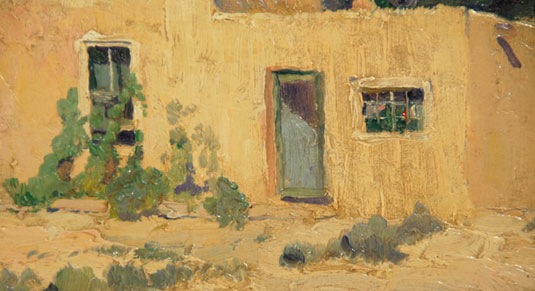Untitled Painting of an Adobe House and Surroundings [SOLD]
+ Add to my watchlist Forward to Friend
- Category: Paintings
- Origin: Western Artists
- Medium: oil on artist board
- Size: 7-3/8” x 9-3/8” image;
14-3/8” x 16-3/8” framed - Item # C3720C SOLD
Charles Berninghaus, impressionist landscape painter, came by art quite naturally because his father, Oscar E. Berninghaus, had already made a name for himself in the art world by the time Charles was born. Oscar first arrived in Taos in 1899 and was one of the six founders of the Taos Society of Artists, that well-known group that even today is known for the outstanding work its members produced.
(Julius) Charles Berninghaus was born May 19, 1905 in St. Louis, Missouri. His first trip to Taos was made when he was five years old. After his mother died in 1913, he and his older sister Dorothy, spent summers in Taos with their father. They grew up knowing all the early artists with whom their father associated, both in Taos and St. Louis.
Charles had an opportunity to see how all these artists worked, and always had access to paints and canvas. He attended St. Louis schools through high school, graduating in 1924, followed by art training at the St. Louis School of Fine Arts, the Art Institute of Chicago, and the Art Students League in New York.
After a short time in the overcrowded environment of New York, Charles knew he preferred the clear skies of New Mexico and became a permanent resident of Taos in 1927. He was encouraged by his father, but never pushed to follow in his footsteps. Oscar knew Charles would have to find his own path and style. And this he did.
Charles' paintings are much more impressionistic than his fathers. He painted outdoors almost exclusively, and painted very fast in order to catch the "light” of the moment. He used only one brush, wiping it clean before each change of color. Landscapes without figures are most common, as Charles loved the country, flowers, trees, and streams of New Mexico. The whole outdoors was his studio and he carried his equipment in his car with him at all times.
The first exhibition in which Charles participated was at the Museum of Fine Arts in Santa Fe in October 1922. At that time Charles was 17 years old and not yet a high school graduate! There were many later exhibitions all over the United States.
Charles put the old fashioned practice of "barter" to good use. Records show many trades of paintings for auto repairs, tires, tennis equipment, art supplies, radios, batteries etc. In 1938 he traded a 12- x 14-inch painting called "Spring Aspens" to Mrs. Nicolai Fechin for a Nash automobile!
Charles' more modern and impressionistic paintings served as a transition from the works of the early Taos artists to that of Robert Daughters, Rod Goebel, Walt Gonske and others. His work became more abstract and loose as he aged, mostly because he didn't believe in paying an ophthalmologist for glasses when he really needed them. The dime store variety was all he ever used.
- Above biographical information source: excerpted from Ask Art from information provided by Barbara Brenner, niece of Charles Berninghaus
![]() This small painting is probably an older one by the artist as it is signed J. Charles Berninghaus. A later painting with which we are familiar does not have the initial J with his signature. It also lacks the looseness and abstract nature of his later paintings when he was in need of eye glasses. The brush strokes are soft and firm. The adobe building commands the attention of the viewer and the dark green tree anchors the upper corner of the painting as a balance of the lightness of the blue sky with clouds. Hidden behind the adobe house is a pitched roof building with a bell tower—either a church or school building.
This small painting is probably an older one by the artist as it is signed J. Charles Berninghaus. A later painting with which we are familiar does not have the initial J with his signature. It also lacks the looseness and abstract nature of his later paintings when he was in need of eye glasses. The brush strokes are soft and firm. The adobe building commands the attention of the viewer and the dark green tree anchors the upper corner of the painting as a balance of the lightness of the blue sky with clouds. Hidden behind the adobe house is a pitched roof building with a bell tower—either a church or school building.
Condition: the painting is in excellent condition
Provenance: from the estate of John and Dixie Yaple, owners of a gallery in the La Fonda Hotel in Taos from 1945-1949, and then director and curator, respectively, of The Millicent Rogers Museum from 1950 to 1977.

- Category: Paintings
- Origin: Western Artists
- Medium: oil on artist board
- Size: 7-3/8” x 9-3/8” image;
14-3/8” x 16-3/8” framed - Item # C3720C SOLD



